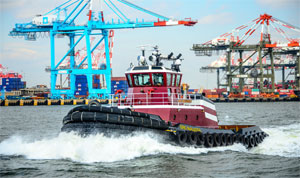Capt. Mike Schnepp, a docking pilot in the Port of New York and New Jersey, was aboard a new McAllister z-drive tug about to rendezvous with an arriving containership, when he explained the essence of his job: guiding ships safely around Bergen Point.
Bergen Point is where ships headed for the container terminals in New Jersey have to make a 120-degree turn to round the point as they exit the Kill Van Kull and enter Newark Bay. In other words, the turn at Bergen Point is the most difficult place ships must navigate along the route leading to the major container terminals in the port complex.
“That’s why I have a job,” said Schnepp, a member of the Harbor Pilots of NY NJ. “I am really here to get a ship safely to its berth. Also to protect McAllister’s equipment.”
The tug Schnepp was riding, the 98-foot 5,150-hp Eric McAllister, has given him a powerful new tool for doing his job safely and efficiently.
“Compared to a traditional boat, these (z-drive) boats are phenomenal,” Schnepp said. “They can do so much more.”
Eric McAllister, designed by Jensen Maritime of Seattle and built by Senesco Shipyard in North Kingstown, R.I., was delivered to McAllister in October 2014. In just a short time, it has established itself as the workhorse of the McAllister fleet, serving the busiest container port in the eastern United States.
McAllister’s New York/New Jersey operations are based on Staten Island on the south shore of the Kill Van Kull within sight of Bergen Point on the far side of the Kill. To rendezvous with the incoming containership on this morning in late March, Eric McAllister traveled east along the length of the Kill Van Kull to New York’s Upper Bay. There, with the skyscrapers of Lower Manhattan silhouetted against the gray sky to the north, Eric McAllister waited for the 758-foot containership Christina Star to pass under the long sweeping arc of the Verrazano-Narrows Bridge about a mile to the south.
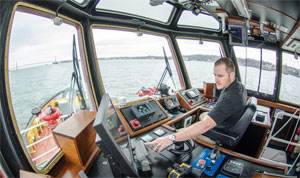 |
|
Capt. Matt Kicklighter is at the controls. |
At the controls of Eric McAllister as it awaited the containership was Capt. Matt Kicklighter, a hawsepiper who is also a fourth-generation mariner. Kicklighter has been working aboard Eric McAllister since the company took delivery of the boat. The tug has two crews that work schedules of two weeks on and two weeks off. (Tugboating definitely runs in the Kicklighter family: when Matt is on his two weeks off, his brother Josh takes over as Eric McAllister’s master.) So the boat is their home half of the time. And it has proven itself to be a comfortable one, especially in comparison to other vessels Matt Kicklighter has known.
“All the tugs I’ve been on, it’s like camping out for two weeks,” he said. But Eric McAllister is different. “The boat is exceptionally smooth and quiet. There’s no problem going to sleep here.”
He described the boat as nicely laid out, with comfortable bunks and high-quality appliances in the galley. “It’s got every comfort of home,” he said, including satellite TV and thermostats in each of the four staterooms.
Kevin Erlwein, the engineer, is also a fan of the new boat. A 2006 SUNY Maritime College grad, he spent the previous five years working as McAllister’s port engineer in Norfolk, Va. In October 2014 he transferred to New York/New Jersey to become a member of the Eric McAllister crew.
During a short tour of the machine spaces before the tug fired up its engines and set out to meet Christina Star, he explained that he had spent some time at the Senesco yard in Rhode Island as construction of Eric McAllister was coming to an end. “I came a little early and helped with the final stages of the project. It was good to know the boat before it was delivered.”
Since coming aboard Eric McAllister, he has found the tug to be a well-thought-out boat that is a good place to work. He especially appreciates the engine control room, a type of space that very few tugs can boast.
“One of the better things about the boat is this control room,” he said. The space was constructed to make it as quiet as possible. The bulkhead separating the control room from the engine room is sheathed in three inches of mineral wool, a layer of lead and an outer layer of one and a half inches of mineral wool with a faced outer surface that can be painted.
“You can start them up,” he said of the engines, “and still hear each other,” even when the engines are at full power.
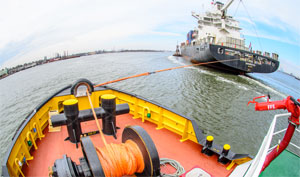 |
|
Employing its JonRie Series 250 escort winch, Eric McAllister has a line up to the 758-foot containership Christina Star. |
The designers “took our input on the (alarm) panel and how we wanted it set up,” Erlwein said. There are three other alarm panels on the boat: in the wheelhouse, galley and one in the engineer’s stateroom.
The machinery spaces are much more spacious than those of a typical tug. “In the z-drive room, you’ve got head space. You can stand up in it,” Erlwein said.
That makes working around the z-drives much easier.
The crew have taken advantage of the spaciousness of the engine room in a somewhat unusual way — by installing a rowing machine and equipment for weightlifting. “You’ve got to have a little cardio when you’re sitting on the boat all the time,” Erlwein said.
Livability and crew comfort are important elements in the design of a modern tug, but tugs are not yachts. They have a job to do, safely and efficiently.
Kicklighter said he has been impressed by the boat’s stability. “It’s one of the most stable platforms I’ve been on,” he said. That stability is especially important when the tug is in the indirect mode because of the powerful lateral forces that can make a tug lean substantially. “When the tug starts to lean, you’ve got to be careful,” Kicklighter said. Not because of stability issues with the boat, but because “you don’t want to throw people out of their bunks.”
As a 5,150-hp z-drive, Eric McAllister is both powerful and highly maneuverable. But it also brings a soft touch to the job because of its extensive fendering both above and below the waterline. The boat has Shibata cylindrical fendering on the upper bow with Viking soft-loop fendering below, along with D fenders along both sides and Viking laminate along the chines and on the stem.
“Some boats land kind of hard,” Kicklighter said. “This boat is very forgiving.”
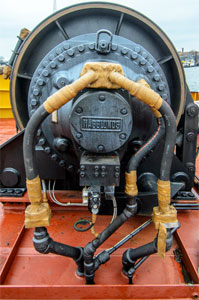 |
|
The Hagglunds winch motor that powers Eric McAllister’s JonRie bow winch, which is able to maintain constant tension on the Samson synthetic line. This feature is instrumental in managing the great forces associated with escorting large ships. |
At about 1040, Eric McAllister was idling near the No. 2 buoy in the Upper Bay when Christina Star passed under the Verrazano Bridge. As Schnepp left the pilothouse to prepare to board the containership, deck hand Pete Dean went with him to assist with the pilot ladder.
Kicklighter explained that boarding speed would be 7 knots or less. Once the docking pilot was aboard, Eric McAllister and The McAllister Sisters — a traditional 120-foot, twin-screw, 4,000-hp boat — would accompany the ship to Bergen Point and then a short distance from there to the Maher Terminal in Port Elizabeth.
With a relatively small containership like Christina Star, the normal procedure when making the turn at Bergen Point would be to have one tugboat push from a point near the starboard quarter, while the second tug pushed against the port bow, thereby pivoting the ship to starboard.
Like other many other major ports on the East Coast, New York/New Jersey is preparing for the arrival of much larger containerships once the Panama Canal’s new locks go into operation. Expected to be ready in early 2016, the new locks will the able to accommodate ships nearly 1,400 feet in length.
When ships 1,000 feet or more in length begin coming to the port, Eric McAllister’s escort capabilities will become crucial. The new tug will be able to turn and slow large ships in ways that traditional tugs cannot.
At Schnepp’s request, Kicklighter brought the tug up to Christina Star’s stern, allowing Dean to send a messenger line up to the ship’s crew, who used it to haul the tug’s hawser aboard. Now with a line up to the ship’s stern, Eric McAllister could demonstrate its escorting abilities.
“I could plink out to either side and slow him down or turn him quickly,” Kicklighter explained.
The tug has a JonRie Series 250 escort winch on the bow with the ability to maintain constant tension on the Samson 12 synthetic line. “The winch is great,” Kicklighter said. “It amazes me, these lines and these winches. They’re super strong.”
All that strength is needed in a tug like Eric McAllister with a bollard pull of 66.5 tons. And the force on the line could be even greater in some maneuvers.
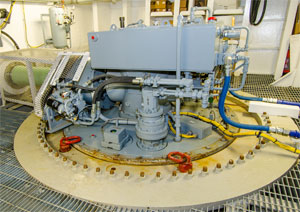 |
|
A Schottel z-drive contributes to Eric McAllister’s maneuverability. The z-drive space has much more headroom than in most tugs, making it easier to maintain the machinery. |
On this day, Eric McAllister’s gear would not be subjected to such tremendous forces. The ship and the two tugs were making their way along the Kill Van Kull at a leisurely 5 knots. They were in no hurry because another ship was still at the berth where Christina Star was to dock.
“He’s dogging it,” Kicklighter said. “There’s a ship at his berth. He’s got to go slow.”
Kicklighter simply tried to keep the line to the ship taut. “We’ll just run with him, just a little bit of tension,” Kicklighter said. “You’re just being drug along a little. He doesn’t even feel us back here.”
However, in the event of an emergency — such as the ship losing propulsion or steering — the tug could make its presence felt in a big way. Kicklighter explained that he could slow the ship using a maneuver called transverse arrest. It involves turning each thruster outboard and going to full power.
“You put the thrusters out and increase thrust to create a wall of water,” he said. That “wall” at right angles to the path of the ship acts like a brake.
“That will be common practice, once we get the big ships in,” he said.
As the little convoy approached Bergen Point, Kicklighter was still uncertain how Schnepp would use the tugs to make the turn. “We’re going so slow, we may just go direct rather than indirect,” he said.
Just before the Point, as the vessels were nearing the Bayonne Bridge, Kicklighter remarked on how dangerous this spot could be, given the sharpness of the turn and the high volume of vessel traffic. “A bunch of bad accidents have happened here over the years,” he said.
Now the decision was made that Eric McAllister would use the indirect mode to guide Christina Star around the Point. At 1144, as the stern of the ship was passing under the bridge, Kicklighter turned to port so that the tug was running at an angle to the ship.
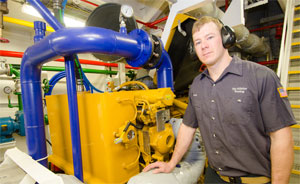 |
|
Eric McAllister’s chief engineer, Kevin Erlwein, tends to the tug’s Caterpillar 3516CHD main engines. Erlwein can monitor the propulsion system from a sound-insulated control room adjacent to the engine room, a space that is very unusual for a tugboat. |
“I’m setting myself up. I’m not putting any pressure yet,” he said. Then as the tension on the line increased modestly, he said, “Now we’re doing it,” and the tug was in the indirect mode. At the same time, The Sisters was pushing on the port bow.
“This is probably all this ship needs,” Kicklighter said. “If we were doing one of those big ones, we’d have to hook it up,” or in other words, use full throttle. “This is a relatively small ship with a good rudder. The Sisters (is) there just in case the bow doesn’t come around.”
The turning maneuver was made easier because it occurred at slack tide, so no currents were adding to the forces at play. “Right now this is kind of relaxed and easy around the Point,” he said.
By 1149, the ship had safely cleared the Point. With that done and with his watch officially coming to an end at 1200, Kicklighter turned the controls over to Zach Newton, the mate, for the docking of the ship.
Newton, a relative newcomer to the tug, was serving just his second two-week rotation aboard. “The capability of the boat is cutting-edge,” he said. “It is important to live up to the capabilities of the boat. … It’s good to have an understanding of what they are capable of doing and then do it.”
With Eric McAllister positioned aft and The Sisters at the bow, the two tugs had soon nudged the ship gently against the dock. By 1240 Schnepp had debarked from the ship and made his way along the dock to Eric McAllister.
With the ship safely secured and the docking pilot aboard, Eric McAllister headed down the channel for the short ride back to its base on Staten Island, standing ready to assist the biggest ships around.
SPECIFICATIONS
Owner: McAllister Towing of New York
Builder: Senesco Shipyard
Designer: Jensen Maritime
Dimensions: 98’ x 36’ x 16.5’
Mission: Ship assist and escort
Crew size: 5; berthing for 7 in four staterooms
Propulsion:
Engines: (2) Caterpillar 3516CHD Tier 3, 5,150 hp total
Bollard pull: 66.5 tons
Speed: 13 knots
Propellers: 2,400-mm four-blade nibral
Gearbox: Lufkin
Thrusters: (2) ASD Schottel 1215FP
Auxiliary generators: (2) John Deere 6068 99-kW Marathon generators, switchboard with auto start/auto transfer
Deck equipment:
Winches: JonRie Series 250 escort winch forward, JonRie Series 230 line winch aft
Cordage: Samson Saturn 12 2 5/8” line
Fendering: 400 x 200 x 11,000 mm and 700 x 350 x 11,000 mm cylindrical on upper bow with Viking soft below; two rows of 300 x 300 mm D-fender port and starboard with 46” airplane tires over; Viking laminated fenders on the chines and laminated stem fender
Navigation gear:
Radar: Furuno FR8252/12” LCD/25 kW with 96NM/ 6’ array, Furuno FR8122/12” LCD/12 kW with 72NM/ 4’ array; both with Rate Compass Interface/ARPA target tracker/AIS interface
Compass: Ritchie
AIS: Furuno FA150
E-nav software: Rose Point
Autopilot: Simrad AP50
Communications:
Radio: (2) Icom M604, (2) Icom M504
Capacities:
Fuel: 30,628 gallons
Water: 6,303 gallons
Ballast: 18,090 gallons
Firefighting:
Monitors: (2) FSS 1,500-gpm manual control monitors
Pump: SFP 3,000-gpm pump driven by a dedicated diesel engine
Onboard fire suppression systems: Fixed CO2
Coatings:
Hull: International
Specialty paints: Mascoat Delta T anti-sweat applied to exterior steel in pilothouse, main deck house and steering compartment. Mascoat Sound Dampening coating applied in engine room overhead and forward bulkhead adjacent to the crew quarters

